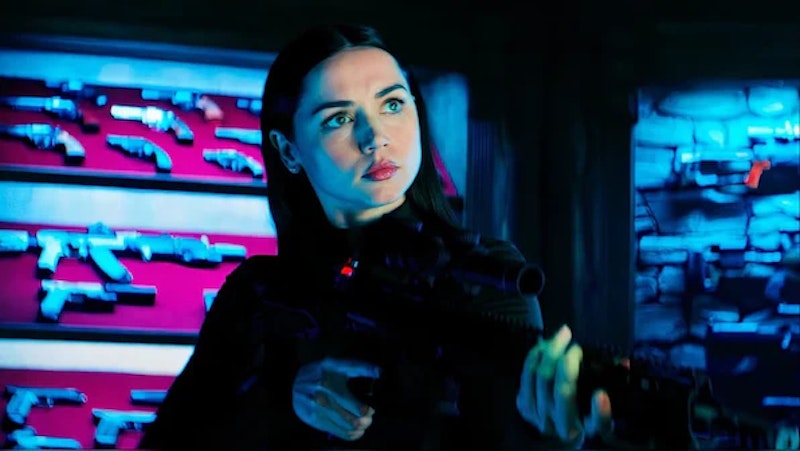I’ve always liked a femme fatale. Especially the kind who gets her way not primarily with coy downward glances or by blinking long luscious lashes but who can kick her foe across the room with leather-clad legs.
For me this began with the late Diana Rigg’s character Mrs. Peel, in the last three years of the 1960s spy comedy, The Avengers. Rigg replaced her sister Bond girl, actress Honor Blackman, as the female half of a pair of spy partners who’d solve mysteries and fight bad guys in often Syfy adjacent plots. Though brilliant, Mrs. Peel also had a leather suit akin to a Cat Woman or Bat Girl and used her skill at martial arts to dispatch villains more often than did her male partner (who seemed to have learned how to fence at university and employed his umbrella as a weapon).
Mrs. Peel’s had various cinematic daughters: Uma Thurman’s The Bride in Kill Bill; Sarah Michelle Gellar as Buffy Summers in Buffy, The Vampire Slayer; Jennifer Garner as Sydney Bristow in Alias; and above all, Summer Glau as River Tam in Joss Whedon’s depiction of a lab created futuristic slayer in Firefly.
Why do we find these petite pugilists so intriguing? Do young male fans feel more masculine if a tough girl wants them and recognizes their (superior) masculinity? Maybe. I often wonder if these girls are popular with gay guys because one doesn’t actually have to be masculine with or for them—they can protect themselves. On screen these characters only work when the actresses involved, even if they’re tall, leggy, or experts in martial arts, are also slim, feminine, and gorgeous. No gigantic, out of shape, or dykey fighting girl has starred in a successful show. Rosie O’Donnell never played a super hero.
There are also femme fatale shows where the protagonist is a very bad girl. Killing Eve was great, and people found themselves rooting for Jodie Comer’s Villanelle, a sociopath trained by an intelligence agency to be a mercenary assassin who’d murder anyone you wished if you could pay her enough to augment her loudly colored, haute couture wardrobe. For four years we were fascinated by Villanelle, even if we didn’t love her and were conflicted about Sandra Oh and British intelligence catching her and taking her down. I’d imagine a heterosexual male viewer might recoil though from the idea of spending a night in the spider’s web, in a way that he wouldn’t if it were Mrs. Peel or Buffy Summers.
It was with this background in mind that I went to see the new John Wick universe movie, The Ballerina. The title suggested that the female assassin, another Eve, played by Cuban-born actress Ana de Armas, would be performing the mesmerizing gymnastics Summer Glau gave us in Firefly. But de Armas (who looks a bit like Mia Kirschner) does lots of stabbing and shooting, some flame throwing and grenade launching, gets thrown through doors and into walls herself, but spends most of the film in a heavy winter coat in an icy village (filmed in Hungary, but the inhabitants speak German), with few balletic martial arts moves. She’s 5’6”, the same height as Glau and taller than Gellar. But she didn’t learn the beautiful twists and twirls, and isn’t costumed for it. She can’t be like River Tam, who flips and catapults across a room of men with guns, wearing only a slip and boots, with an axe in one hand and a machete in the other, landing on her feet in a blood-covered version of a fashion magazine pose with nothing but dead bodies all around her. If you’re really into Wick, the story does give you Gabriel Byrne and Anjelica Huston as bosses of rival families of assassins. John Wick (Keanu Reeves) appears as part of the film’s resolution.
A far better alternative is the German spy series Kleo, available in the U.S. with subtitles on Netflix. The plot of Ballerina is stolen from Kleo. In Ballerina Eve is trying to kill her grandfather, played by Gabriel Byrne, because he killed her father (we later learn Byrne routinely orders the execution of disloyal subordinates, including his own children and grandchildren). Likewise Kleo, secretly still connected to and working for the Soviet and East German secret police even after the fall of the Wall and the reunification of Germany, learns that her mother’s and father’s disappearances were ordered by her Communist Party mentors, friends, relatives. Kleo (actress Jella Haase, who’s nearly a dead ringer for a younger, thinner Elisabeth Moss), definitely on the spectrum, kills a lot of people, shags a few guys, and finally finds out a lot about what happened to her family in 14 episodes over two seasons.

